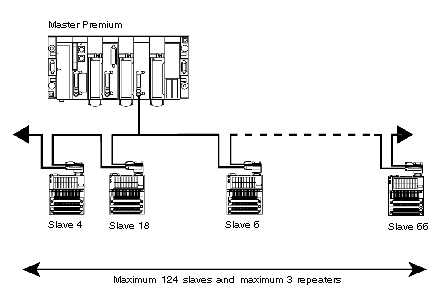The architecture of the Profibus DP field bus is used to implement the TSX PBY 100 module and slave devices.
This illustration shows the shortest network cycle time.
A Profibus DP bus can be made up of several electric and optic segments interconnected by repeaters.
Each of the electric segments must be adapted (impedance) and you must use:
-
Two connectors: ref. 490NAD91103 (yellow) mounted on the devices situated at the ends of each electric segment.
-
For the other connections, you must use these connectors: ref. 499NAD91104 or 490NAD91105 (gray).
You must ensure that there is cable screening continuity at connector level, otherwise the devices may be weakened.
It is advisable to use an optic segment between two constructions or to add surge absorbers on the electric segments.
The protocol principle is based on a master/slave type bus. This principle guarantees excellent response times on I/O type exchanges (cyclic exchanges), with a maximum
network cycle time less than 5 ms at 12 Mbds.
Only the master stations, sometimes called active stations, have access rights to the bus. The slave (or passive) stations can only respond to prompts and requests.
Several types of device are standardized:
-
Master class 1 generally PLC, robot, digital command, etc.
-
Master class 2 configuration devices, programming and master diagnostics.
-
Slaves.
Profibus DP station addressing
Profibus DP stations can be identified by a number between 0 and 124 which defines the number of the station in the architecture (from 1 to 125).
This address corresponds to the station connection point on the bus registered in the configuration.
